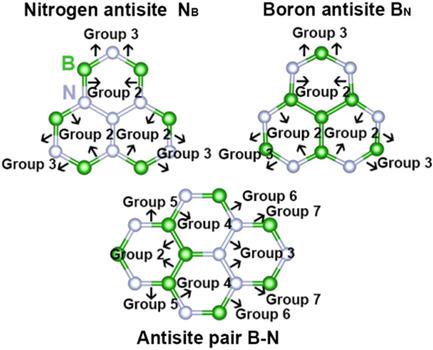当前位置:
X-MOL 学术
›
Phys. Status Solidi. Rapid Res. Lett.
›
论文详情
Our official English website, www.x-mol.net, welcomes your
feedback! (Note: you will need to create a separate account there.)
Effects of Antisite Defect Density on Crystal and Electronic Structures of Monolayer Hexagonal Boron Nitride
Physica Status Solidi-Rapid Research Letters ( IF 2.5 ) Pub Date : 2021-06-22 , DOI: 10.1002/pssr.202100216 Yifan Ding 1, 2 , Junkai Yang 1, 2 , Huaixiang Wang 1, 2 , Yu Ji 1, 2 , Qinwen Guo 1, 2 , Weipeng Wang 1 , Xi Shen 1 , Yuan Yao 1 , Richeng Yu 1, 2
Physica Status Solidi-Rapid Research Letters ( IF 2.5 ) Pub Date : 2021-06-22 , DOI: 10.1002/pssr.202100216 Yifan Ding 1, 2 , Junkai Yang 1, 2 , Huaixiang Wang 1, 2 , Yu Ji 1, 2 , Qinwen Guo 1, 2 , Weipeng Wang 1 , Xi Shen 1 , Yuan Yao 1 , Richeng Yu 1, 2
Affiliation

|
The effect of antisite defects and their density on monolayer hexagonal boron nitride is discussed in detail. Different supercell sizes to simulate different defect densities are set up. All structures containing antisites are fully optimized. It is indicated that the high density of antisite defects leads to the instability of the BB bond. The influence of supercell size on lattice structure is also summarized. Like vacancies and dopant atoms, the antisite defects also lead to the appearance of the defect energy band. Different antisite defect densities have different effects on different orbitals. Electron energy-loss spectroscopy theoretical simulation is conducted on a single atom to analyze the influence of antisite defect density on the electronic structure of a single atom. It is shown that the high density of antisite defects makes the σ* transition of B atoms that are far away from the defect more preferred than π* transition, while it has less influence on the transition of central N atoms of the antisite defect NB because of the influence of neighboring atoms. The concentration of antisite defects plays a key role in manipulating the physical properties of monolayer hexagonal boron nitride and is helpful in expanding potential application scenarios.
中文翻译:

反位缺陷密度对单层六方氮化硼晶体和电子结构的影响
详细讨论了反位缺陷及其密度对单层六方氮化硼的影响。设置了不同的超级单元尺寸来模拟不同的缺陷密度。所有包含反位点的结构都经过充分优化。这表明,反位缺陷通向B的不稳定性的高密度B 债券。还总结了超胞尺寸对晶格结构的影响。与空位和掺杂原子一样,反位缺陷也会导致缺陷能带的出现。不同的反位点缺陷密度对不同的轨道有不同的影响。对单原子进行电子能量损失谱理论模拟,分析反位缺陷密度对单原子电子结构的影响。结果表明,高密度的反位缺陷使得远离缺陷的B原子的σ *跃迁比π *跃迁更优选,而对反位缺陷N B的中心N原子的跃迁影响较小因为相邻原子的影响。反位缺陷的浓度在操纵单层六方氮化硼的物理性质方面起着关键作用,有助于扩大潜在的应用场景。
更新日期:2021-06-22
中文翻译:

反位缺陷密度对单层六方氮化硼晶体和电子结构的影响
详细讨论了反位缺陷及其密度对单层六方氮化硼的影响。设置了不同的超级单元尺寸来模拟不同的缺陷密度。所有包含反位点的结构都经过充分优化。这表明,反位缺陷通向B的不稳定性的高密度B 债券。还总结了超胞尺寸对晶格结构的影响。与空位和掺杂原子一样,反位缺陷也会导致缺陷能带的出现。不同的反位点缺陷密度对不同的轨道有不同的影响。对单原子进行电子能量损失谱理论模拟,分析反位缺陷密度对单原子电子结构的影响。结果表明,高密度的反位缺陷使得远离缺陷的B原子的σ *跃迁比π *跃迁更优选,而对反位缺陷N B的中心N原子的跃迁影响较小因为相邻原子的影响。反位缺陷的浓度在操纵单层六方氮化硼的物理性质方面起着关键作用,有助于扩大潜在的应用场景。

















































 京公网安备 11010802027423号
京公网安备 11010802027423号